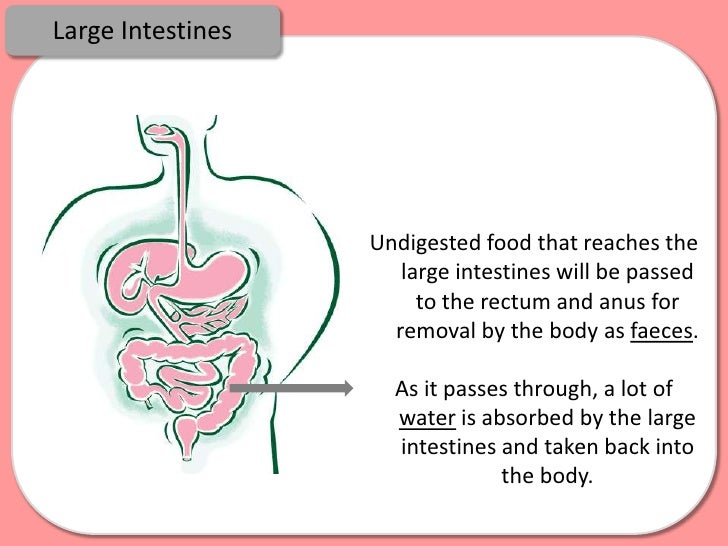

The first happens automatically, and a person cannot control it.
Does the large intestine absorb water full#
The rectumĪs the digested food moves into the rectum, nerves in the wall of the rectum known as stretch receptors detect when the chamber is full and stimulate the desire to defecate.ĭefecation involves two types of muscle movement. Next, peristalsis moves the feces toward the rectum. cecum, a pouch through which food enters from the small intestineįrom the large intestine, the body absorbs water and electrolytes.įood travels slowly through the colon to allow the body to absorb water, and trillions of gut bacteria break down any undigested food.The large intestine is around 6 ft (2 m) long and consists of the: How do the intestines work? The large intestineĪny unabsorbed food and nutrients now pass to the large intestine, or colon. By increasing their surface area, the villi maximize their absorption of nutrients. Within the villi are tiny capillaries called lacteals. Villi are tiny, finger-like projections that line the walls of the small intestine. Once the food is fully broken down, the villi absorb the nutrients, which enter the bloodstream. The ileum: This contains the ileocecal valve, a sphincter through which food passes to the large intestine.The jejunum: Most of the chemical digestion and absorption occur here.The duodenum: This receives chyme from the stomach and digestive enzymes from the liver and pancreas.The small intestine is around 20 ft (6 m) long and absorbs around 90% of the nutrients from food into the bloodstream. How can you increase stomach acid naturally? The small intestine The stomach does not absorb many nutrients from the chyme into the bloodstream, so the chyme enters the small intestine through the pyloric sphincter. The acid, however, can harm the stomach lining, so some cells produce mucus to protect the lining from damage. activating pepsin, an enzyme that helps digest proteins.breaking down proteins and plant fibers.destroying microorganisms, such as bacteria.These processes turn the food into a thick paste, known as chyme. The stomach has three muscular layers that churn and mix its contents.These include hydrochloric acid, which maintains the pH of the stomach between 1.5–2.0. Cells in the stomach secrete gastric juices.The stomach stores the food temporarily.In the stomach, the following processes occur: This sphincter relaxes, allowing the bolus to enter the stomach. The bolus enters the stomach through a ring-like muscle called the lower esophageal sphincter. What is esophageal achalasia, and how does it affect digestion? The stomach Peristalsis is the slow contraction of smooth muscles along and around the digestive system.Īs the bolus moves through the esophagus, these contractions push it toward the stomach. The esophagusĪfter swallowing, the bolus enters the esophagus, where gravity and muscle contractions help move it down to the stomach through a process called peristalsis. This enables a person to swallow it easily. an enzyme in the saliva, salivary amylase, breaks it down into starch.Ĭhewing and amylase digestion will convert the food into a small, round blob, or bolus.the teeth and tongue break it down mechanically.When a person smells or thinks of food or eating, the salivary glands begin producing saliva. defecation and urination, the removal of waste products through the rectum and the bladder, respectivelyĭigestion begins even before the food enters the mouth.the absorption of nutrients, which mainly occurs in the small intestine.digestion, the breakdown of food, for example, through chewing and secretions.

propulsion, where muscles move the contents of the canal forward.the secretion of substances that enable food and nutrients to move through the body effectively.

ingestion, which includes chewing and swallowing.Some terms to describe these functions include: Together, these organs provide mechanical processing, the secretion of enzymes and bile to help break down compounds, and the excretion of waste. In addition, the following organs support digestion, for example, by chewing or adding enzymes and other secretions that enable the body to absorb nutrients: The human gastrointestinal tract, also called the alimentary canal, is around 30 feet (9 meters) long in adults.


 0 kommentar(er)
0 kommentar(er)
